Integrated Carbon-Capture-Based Low-Carbon Economic Dispatch of Power Systems Based on EEMD-LSTM-SVR Wind Power Forecasting
Abstract
:1. Introduction
- There are more studies on split-flow carbon capture power plants but fewer studies on integrated carbon capture power plants. Integrated carbon capture plants applied to the source side have better results and should be studied further.
- Most of the studies deal with wind power prediction by directly applying existing prediction values, but these values often have poor prediction results. There is a need to study prediction models with higher prediction accuracy.
- Few studies have jointly applied precise wind power predictions with integrated carbon capture plants. The low-carbon characteristics and scheduling advantages of the above two tools have not been fully explored, and there is a lack of research on the operational mechanism of the two working together to achieve low carbon.
- First, the EEMD-LSTM-SVR model is used to forecast the wind power in the Belgian grid so that the forecast values are as close as possible to the real values. This allows us to get closer to the real dispatch costs, unit start-up and shutdown plans, and unit output. This provides the grid dispatchers with a better dispatch strategy and avoids the loss of system safety in the pursuit of low dispatch costs.
- Then, the low-carbon economic dispatching model of power system with integrated flexible operation of carbon capture power plant is built by integrating the split-flow type and liquid storage type carbon capture power plant on the traditional thermal power plant.
- Finally, the advantages of the dispatching method proposed in this paper are verified by simulation. The results show that the wind power prediction is more accurate and the dispatching results are closer to the real value based on the original one.
2. Operational Mechanisms Considering Wind Power Uncertainty and Low Carbon Characteristics of Carbon Capture Power Plants
3. Low Carbon Economy Dispatch Modeling
3.1. Dataset
3.1.1. EWMA and SMA Feature Construction of Wind Power
3.1.2. Curve Feature Construction of Wind Power
3.2. EEMD-LSTM-SVR
3.2.1. EEMD
- (1)
- The extreme points of the original signal are demarcated, all the extreme points are collected to form the upper and lower envelope (), and is obtained by means processing for envelope ().
- (2)
- Calculate the difference between the original signal and IMF1 as a calculation input of new round:
- (3)
- Repeat the above steps and finally get n IMF components and residual components .
- (1)
- Add a group of white noise signals to the original data.
- (2)
- Perform EMD decomposition on the new sequence.
- (3)
- Repeat the EMD decomposition, adding white noise of different amplitude each time to obtain N groups of IMF components and residual sequences.
- (4)
- Perform average processing on the N groups of IMF components and integrate them to obtain the EEMD decomposition result.
3.2.2. LSTM
3.2.3. SVR
3.2.4. EEMD-LSTM-SVR with Cross-Validation and Grid Search Tuning
- First, choose a suitable predicting model. This paper has two alternative predicting models: LSTM and SVR.
- Then incremental division is performed for each IMF. The data for 31 December 2021 was removed separately. This part will not participate in the training process because in predicting practical applications, this part is unknown. It is exactly the value we need to predict. The incremental division is used for the first 30 days, and the number of increments is set to 4. Figure 9 shows the schematic.
- The grid search is performed for four different combinations of datasets, where the LSTM is adjusted for the number of hidden layer cells and the number of batches fed into the model each time. Specifically, the number of cells is first adjusted to deter-mine the approximate range in intervals of 10 from 10 to 100, and then the best parameters are searched for in the reduced range in units of 1. The judging criterion is the box plot of the validation loss. After determining the number of cells, it is substituted into the model and the same steps are used to search for the optimal n_batch. The other parameters of the LSTM are set as follows: the optimizer is Adam, the activation method of the fully connected layer is linear, the loss evaluation indicator is MSE, and the epochs-num in each iteration is 250.SVR mainly adjusts the kernel function and penalty factor C. The kernel function includes rbf, linear, and poly. The penalty factor C is tuned in the range from 0.01 to 100 in an isometric series with a total of 10 elements.
- After selecting a suitable prediction model for each IMF and performing cross-validation and grid tuning, the best parameters are used for prediction. The prediction results are superimposed to obtain the final statistical line loss prediction.
3.3. Low Carbon Dispatch Modeling Considering Wind Power Forecasting and Integrated Carbon Capture Power Plants
3.3.1. Optimization Objective
- (1)
- Total start-up and shutdown costs of thermal power units and fuel costs .where, is the unit cost of thermal unit i on and off; n is the total number of thermal units; is the thermal unit on and off status: 1 is on, 0 is off; is the total output of thermal unit i at time t; , , are the fuel cost parameters of thermal unit i.
- (2)
- Carbon trading costs .where is the carbon trading price; is the net carbon emission of a dispatch cycle of the power system; is the length of the time period; is the carbon quota factor of thermal power units.
- (3)
- Cost of wind abandonment penalty . To improve the wind power absorption, the model includes the abandoned wind penalty cost, which is calculated as.where is the abandoned wind penalty cost factor; is the predicted wind power output at time t; is the wind power used at time t.
- (4)
- Depreciation cost of carbon capture equipment .where is the total price of carbon capture equipment except for the storage tank under the base condition; is the cost required for the expansion and renovation of the regeneration tower compressor; ω is the net salvage rate; is the depreciable life of carbon capture equipment except for the storage tank; is the price of the storage tank per unit volume; is the volume of the storage tank; is the depreciable life of the storage tank.
3.3.2. Constraints
- (1)
- Power balance constraint.
- (2)
- Integrated carbon capture power plant constraints.
- (3)
- Rotation standby constraint
4. Case Study and Operational Cases
- Case 1: using wind power forecast data from the Belgian grid without carbon capture power plants.
- Case 2: using wind power forecast data from the Belgian grid, including split-flow carbon capture plants.
- Case 3: using Belgian grid wind forecast data with integrated flexible operation mode carbon capture plants.
- Case 4: using actual wind power data from the Belgian grid as of December 31, including integrated flexible operation carbon capture plants.
- Case 5: wind power forecasts using EEMD-LSTM-SVR, including integrated flexible-operating carbon capture plants.
5. Result
5.1. Analysis of Dispatch Results
5.2. Unit Dispatch Situation Analysis
6. Conclusions
- Compared with conventional thermal power plants, carbon emissions will be reduced by 77.548% with split type carbon capture power plants and by 78.248% with integrated type carbon capture power plants. This proves that carbon capture power plants can effectively reduce carbon emissions.
- In the economic dispatch of the power system, compared with the split carbon capture power plant, the integrated carbon capture power plant can reduce carbon emissions by 10.847%, which proves the effectiveness of the integrated carbon capture power plant in reducing carbon emissions.
- In terms of wind power prediction accuracy improvement, compared with the wind power predicted by the Belgian grid, the total cost of dispatching using the wind power predicted in this paper will be closer to the real situation, with a difference of only 60$.
- Compared with the traditional thermal power plants, the inclusion of the split carbon capture plant reduces the amount of abandoned wind by 53.525%; with the integrated carbon capture plant, the plot energy of wind power can be fully utilized. It proves the effectiveness of integrated carbon capture power plant for absorbing wind power.
- In future work, the economic dispatch of power systems containing carbon capture power plants at multiple time scales will be considered. Meanwhile, the research in this paper does not involve demand-side standby and flexible dispatch, and subsequent studies such as standby-assisted market decision will be considered.
Author Contributions
Funding
Institutional Review Board Statement
Informed Consent Statement
Data Availability Statement
Conflicts of Interest
Abbreviations
| ARIMA | AR Integrated Moving Average |
| CCS | Carbon Capture and Storage |
| CEEMDAN | Complete Ensemble Empirical Mode Decomposition with Adaptive Noise |
| CNN | Convolutional Neural Networks |
| EMD | Empirical Mode Decomposition |
| EEMD | Ensemble Empirical Mode Decomposition |
| ENN | Error Encoding Network |
| EWMA | Exponential Weighted Moving Average |
| ICEEMDAN | Improved Complete Ensemble Empirical Mode Decomposition with Adaptive Noise |
| IMF | Intrinsic Mode Functions |
| LSSVM | Least Squares Support Vector Machines |
| LSTM | Long Short-Term Memory recurrent neural network |
| MEMD | Median EMD |
| MLP | Multilayer Perceptron |
References
- Chen, H.-H.; Hof, A.F.; Daioglou, V.; de Boer, H.S.; Edelenbosch, O.Y.; van den Berg, M.; van der Wijst, K.-I.; van Vuuren, D.P. Using Decomposition Analysis to Determine the Main Contributing Factors to Carbon Neutrality across Sectors. Energies 2022, 15, 132. [Google Scholar] [CrossRef]
- Bi, X.; Yang, J.; Yang, S. LCA-Based Regional Distribution and Transference of Carbon Emissions from Wind Farms in China. Energies 2022, 15, 198. [Google Scholar] [CrossRef]
- Arraño-Vargas, F.; Shen, Z.; Jiang, S.; Fletcher, J.; Konstantinou, G. Challenges and Mitigation Measures in Power Systems with High Share of Renewables—The Australian Experience. Energies 2022, 15, 429. [Google Scholar] [CrossRef]
- Mustafayev, F.; Kulawczuk, P.; Orobello, C. Renewable Energy Status in Azerbaijan: Solar and Wind Potentials for Future Development. Energies 2022, 15, 401. [Google Scholar] [CrossRef]
- Zhang, Z.; Santoni, C.; Herges, T.; Sotiropoulos, F.; Khosronejad, A. Time-Averaged Wind Turbine Wake Flow Field Prediction Using Autoencoder Convolutional Neural Networks. Energies 2022, 15, 41. [Google Scholar] [CrossRef]
- Zhu, T.; Guo, Y.; Li, Z.; Wang, C. Solar Radiation Prediction Based on Convolution Neural Network and Long Short-Term Memory. Energies 2021, 14, 8498. [Google Scholar] [CrossRef]
- Quan, H.; Srinivasan, D.; Khosravi, A. Short-Term Load and Wind Power Forecasting Using Neural Network-Based Prediction Intervals. IEEE Trans. Neur. Net. Lear. Syst. 2014, 25, 303–315. [Google Scholar] [CrossRef]
- Du, J.; Yue, C.; Shi, Y.; Yu, J.; Sun, F.; Xie, C.; Su, T. A Frequency Decomposition-Based Hybrid Forecasting Algorithm for Short-Term Reactive Power. Energies 2021, 14, 6606. [Google Scholar] [CrossRef]
- Mao, L.; Xu, J.; Chen, J.; Zhao, J.; Wu, Y.; Yao, F. A LSTM-STW and GS-LM Fusion Method for Lithium-Ion Battery RUL Prediction Based on EEMD. Energies 2020, 13, 2380. [Google Scholar] [CrossRef]
- Bokde, N.; Feijóo, A.; Al-Ansari, N.; Tao, S.; Yaseen, Z.M. The Hybridization of Ensemble Empirical Mode Decomposition with Forecasting Models: Application of Short-Term Wind Speed and Power Modeling. Energies 2020, 13, 1666. [Google Scholar] [CrossRef] [Green Version]
- Mora, E.; Cifuentes, J.; Marulanda, G. Short-Term Forecasting of Wind Energy: A Comparison of Deep Learning Frameworks. Energies 2021, 14, 7943. [Google Scholar] [CrossRef]
- Thuraisingham, R.A. Revisiting ICEEMDAN and EEG rhythms. Biomed. Signal Proces. Control 2021, 68, 102701. [Google Scholar] [CrossRef]
- Bokde, N.D.; Tranberg, B.; Andresen, G.B. Short-term CO2 emissions forecasting based on decomposition approaches and its impact on electricity market scheduling. Appl. Energy 2021, 281, 116061. [Google Scholar] [CrossRef]
- Zhang, J.; Williams, S.O.; Wang, H. Intelligent computing system based on pattern recognition and data mining algorithms, Sustain. Comput. Infor. Syst. 2018, 20, 192–202. [Google Scholar]
- Xia, Y.; Zhao, J.; Ding, Q.; Jiang, A. Incipient Chiller Fault Diagnosis Using an Optimized Least Squares Support Vector Machine with Gravitational Search Algorithm. Front. Energy Res. 2021, 9, 717. [Google Scholar] [CrossRef]
- Chen, T.; Song, M.; Hui, H.; Long, H. Battery Electrode Mass Loading Prognostics and Analysis for Lithium-Ion Battery–Based Energy Storage Systems. Front. Energy Res. 2021, 9, 543. [Google Scholar] [CrossRef]
- Bokde, N.D.; Feijóo, A.; Al-Ansari, N.; Yaseen, Z.M. A comparison between reconstruction methods for generation of synthetic time series applied to wind speed simulation. IEEE Access 2019, 7, 135386–135398. [Google Scholar] [CrossRef]
- Liu, Z.; Li, L.; Tseng, M.L.; Tan, R.R.; Aviso, K.B. Improving the Reliability of Photovoltaic and Wind Power Storage Systems Using Least Squares Support Vector Machine Optimized by Improved Chicken Swarm Algorithm. Appl. Sci. 2019, 9, 3788. [Google Scholar] [CrossRef] [Green Version]
- Zheng, Q.; Yan, P.; Zareipour, H.; Niya, C. A review and discussion of decomposition-based hybrid models for wind energy forecasting applications. Appl. Energy 2019, 235, 939–953. [Google Scholar]
- Ma, L. Inter-Provincial Power Transmission and Its Embodied Carbon Flow in China: Uneven Green Energy Transition Road to East and West. Energies 2022, 15, 176. [Google Scholar] [CrossRef]
- Olaleye, A.K.; Wang, M.; Kelsall, G. Steady state simulation and exergy analysis of supercritical coal-fired power plant with CO2 capture. Fuel 2015, 151, 57–72. [Google Scholar] [CrossRef]
- Theo, W.L.; Lim, J.S.; Hashim, H.; Mustaffa, A.A.; Ho, W.S. Review of pre-combustion capture and ionic liquid in carbon capture and storage. Appl. Energy 2016, 183, 1633–1663. [Google Scholar] [CrossRef]
- LI, J.; WEN, J.; HAN, X. Low-carbon unit commitment with intensive wind power generation and carbon capture power plant. J. Mod. Power Syst. Clean Energy 2015, 3, 63–71. [Google Scholar] [CrossRef] [Green Version]
- Sun, S.; Wei, L.; Xu, J.; Jin, Z. A New Wind Speed Forecasting Modeling Strategy Using Two-Stage Decomposition, Feature Selection and DAWNN. Energies 2019, 12, 334. [Google Scholar] [CrossRef]
- Elsaraiti, M.; Merabet, A. A Comparative Analysis of the ARIMA and LSTM Predictive Models and Their Effectiveness for Predicting Wind Speed. Energies 2021, 14, 6782. [Google Scholar] [CrossRef]
- Alharbi, F.R.; Csala, D. Wind Speed and Solar Irradiance Prediction Using a Bidirectional Long Short-Term Memory Model Based on Neural Networks. Energies 2021, 14, 6501. [Google Scholar] [CrossRef]
- Sigalo, M.B.; Pillai, A.C.; Das, S.; Abusara, M. An Energy Management System for the Control of Battery Storage in a Grid-Connected Microgrid Using Mixed Integer Linear Programming. Energies 2021, 14, 6212. [Google Scholar] [CrossRef]
- Mohammad, F.; Ahmed, M.A.; Kim, Y.-C. Efficient Energy Management Based on Convolutional Long Short-Term Memory Network for Smart Power Distribution System. Energies 2021, 14, 6161. [Google Scholar] [CrossRef]
- Xie, Y.; Ueda, Y.; Sugiyama, M. A Two-Stage Short-Term Load Forecasting Method Using Long Short-Term Memory and Multilayer Perceptron. Energies 2021, 14, 5873. [Google Scholar] [CrossRef]
- Chung, J.; Gulcehre, C.; Cho, K.H.; Bengio, Y. Empirical evaluation of gated recurrent neural networks on sequence modeling. arXiv 2014, arXiv:1412.3555. [Google Scholar]
- Khan, P.W.; Byun, Y.-C.; Lee, S.-J.; Kang, D.-H.; Kang, J.-Y.; Park, H.-S. Machine Learning-Based Approach to Predict Energy Consumption of Renewable and Nonrenewable Power Sources. Energies 2020, 13, 4870. [Google Scholar] [CrossRef]
- Kim, Y.; Hur, J. An Ensemble Forecasting Model of Wind Power Outputs Based on Improved Statistical Approaches. Energies 2020, 13, 1071. [Google Scholar] [CrossRef] [Green Version]
- Tang, M.; Chen, W.; Zhao, Q.; Wu, H.; Long, W.; Huang, B.; Liao, L.; Zhang, K. Development of an SVR Model for the Fault Diagnosis of Large-Scale Doubly-Fed Wind Turbines Using SCADA Data. Energies 2019, 12, 3396. [Google Scholar] [CrossRef] [Green Version]
- Kim, K.; Hur, J. Weighting Factor Selection of the Ensemble Model for Improving Forecast Accuracy of Photovoltaic Generating Resources. Energies 2019, 12, 3315. [Google Scholar] [CrossRef] [Green Version]
- Tan, B.; Ke, X.; Tang, D.; Yin, S. Improved Perturb and Observation Method Based on Support Vector Regression. Energies 2019, 12, 1151. [Google Scholar] [CrossRef] [Green Version]
- Abualigah, L.; Zitar, R.A.; Almotairi, K.H.; Hussein, A.M.; Abd Elaziz, M.; Nikoo, M.R.; Gandomi, A.H. Wind, Solar, and Photovoltaic Renewable Energy Systems with and without Energy Storage Optimization: A Survey of Advanced Machine Learning and Deep Learning Techniques. Energies 2022, 15, 578. [Google Scholar] [CrossRef]
- Jin, J.; Wen, Q.; Zhang, X.; Cheng, S.; Guo, X. Economic Emission Dispatch for Wind Power Integrated System with Carbon Trading Mechanism. Energies 2021, 14, 1870. [Google Scholar] [CrossRef]
- Liu, J.; Sun, W.; Harrison, G.P. Optimal Low-Carbon Economic Environmental Dispatch of Hybrid Electricity-Natural Gas Energy Systems Considering P2G. Energies 2019, 12, 1355. [Google Scholar] [CrossRef] [Green Version]
- Wang, X.; Zhou, Y.; Tian, J.; Wang, J.; Cui, Y. Wind Power Consumption Research Based on Green Economic Indicators. Energies 2018, 11, 2829. [Google Scholar] [CrossRef] [Green Version]
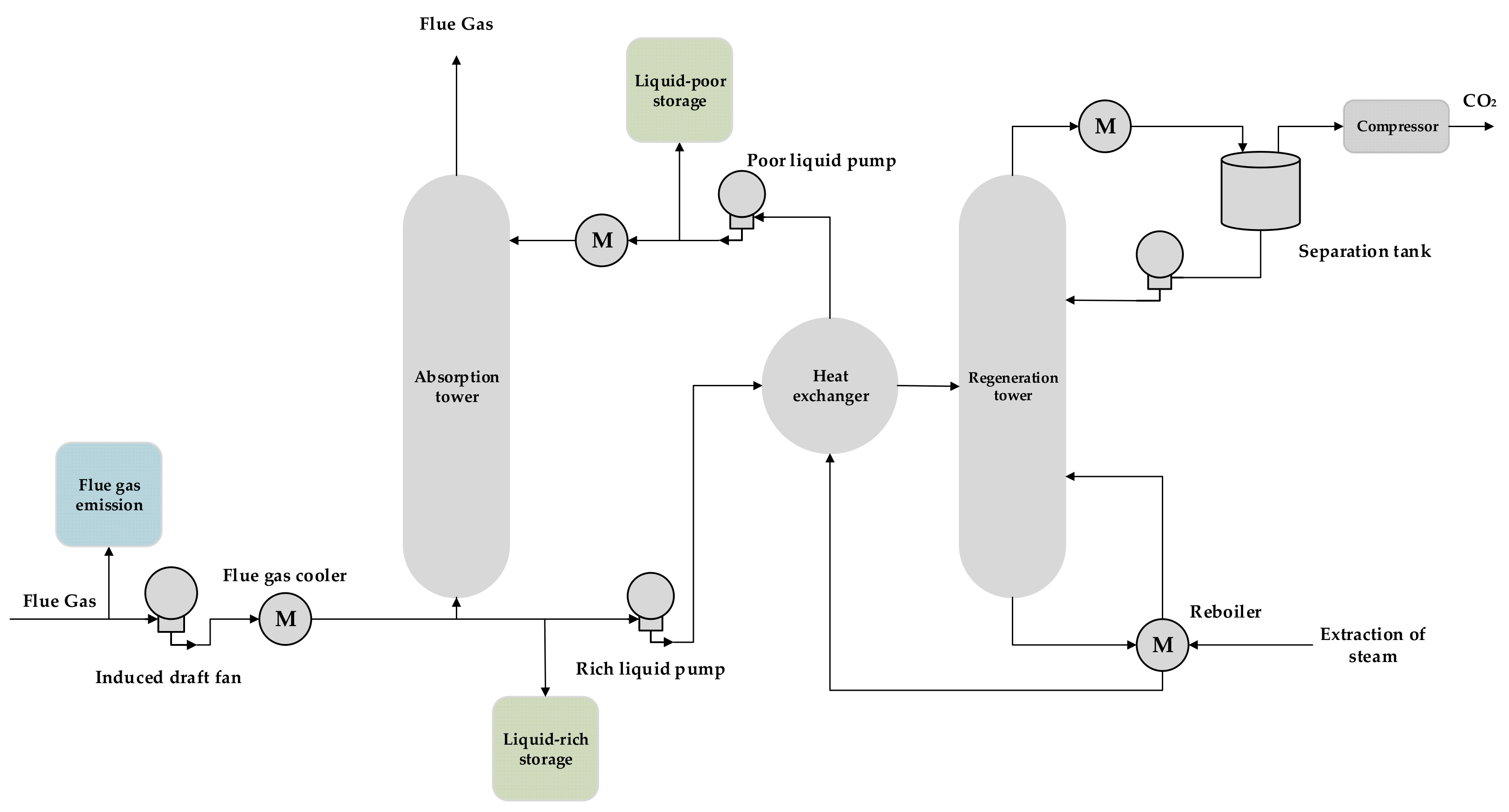
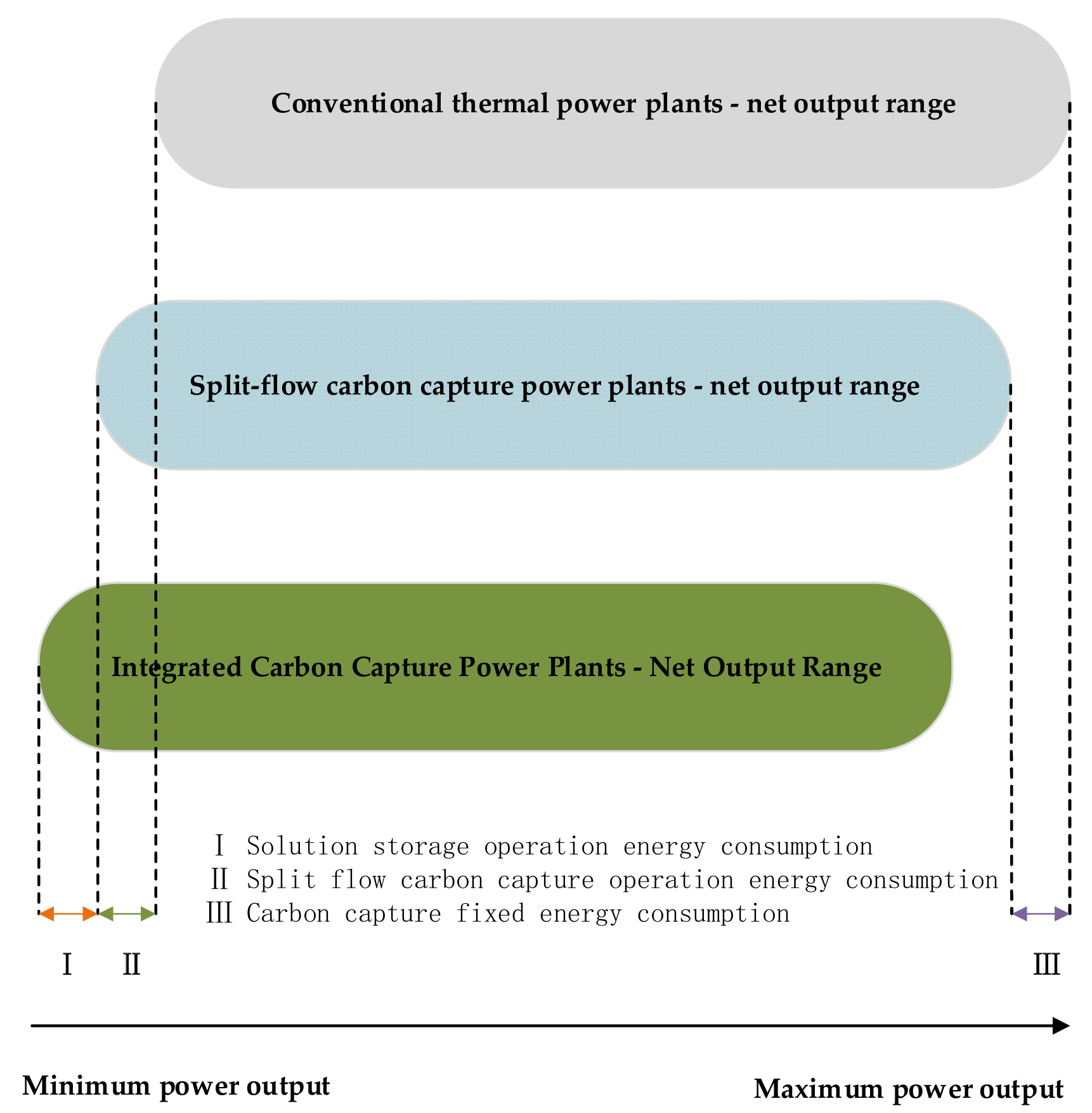
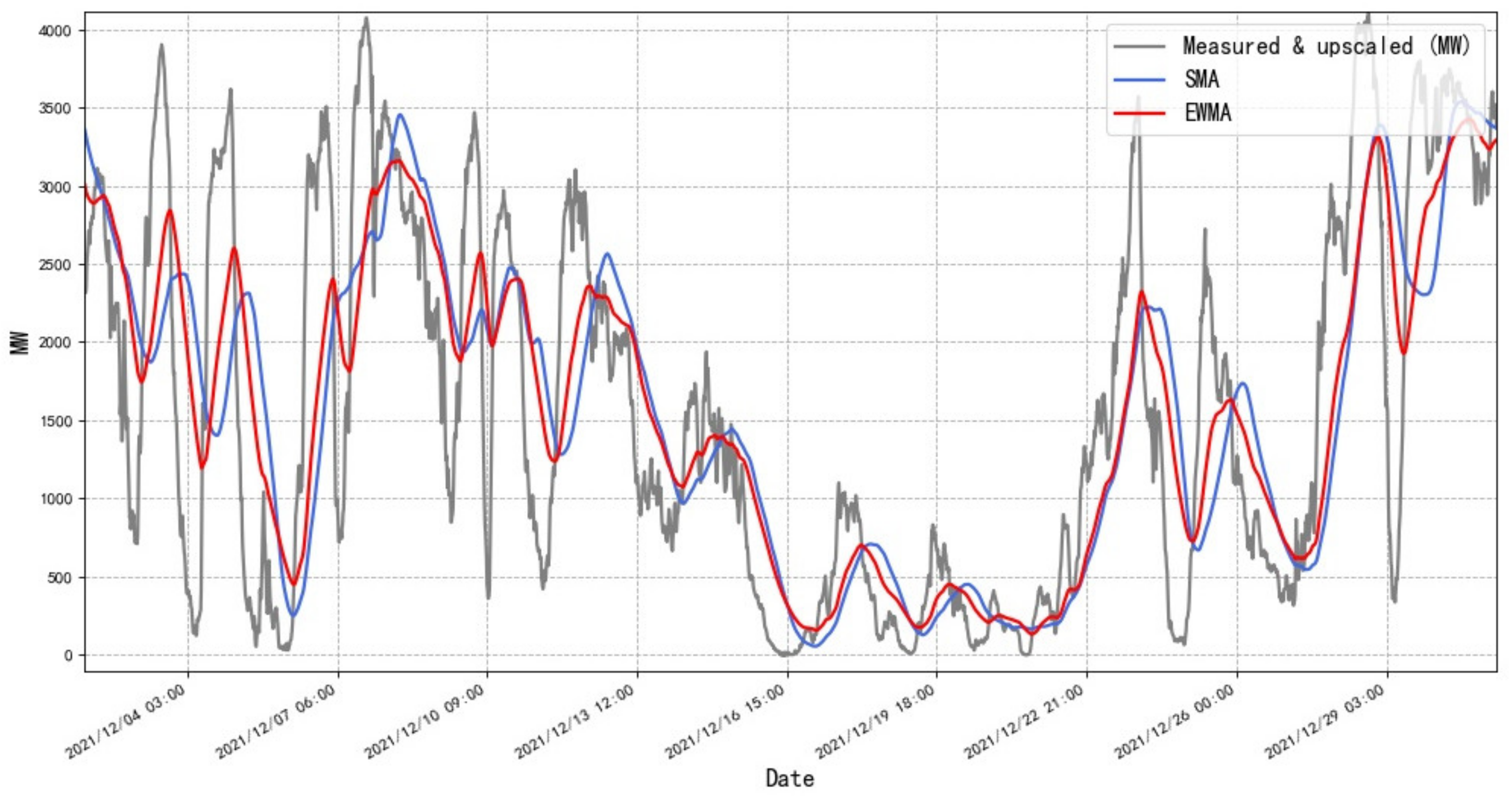
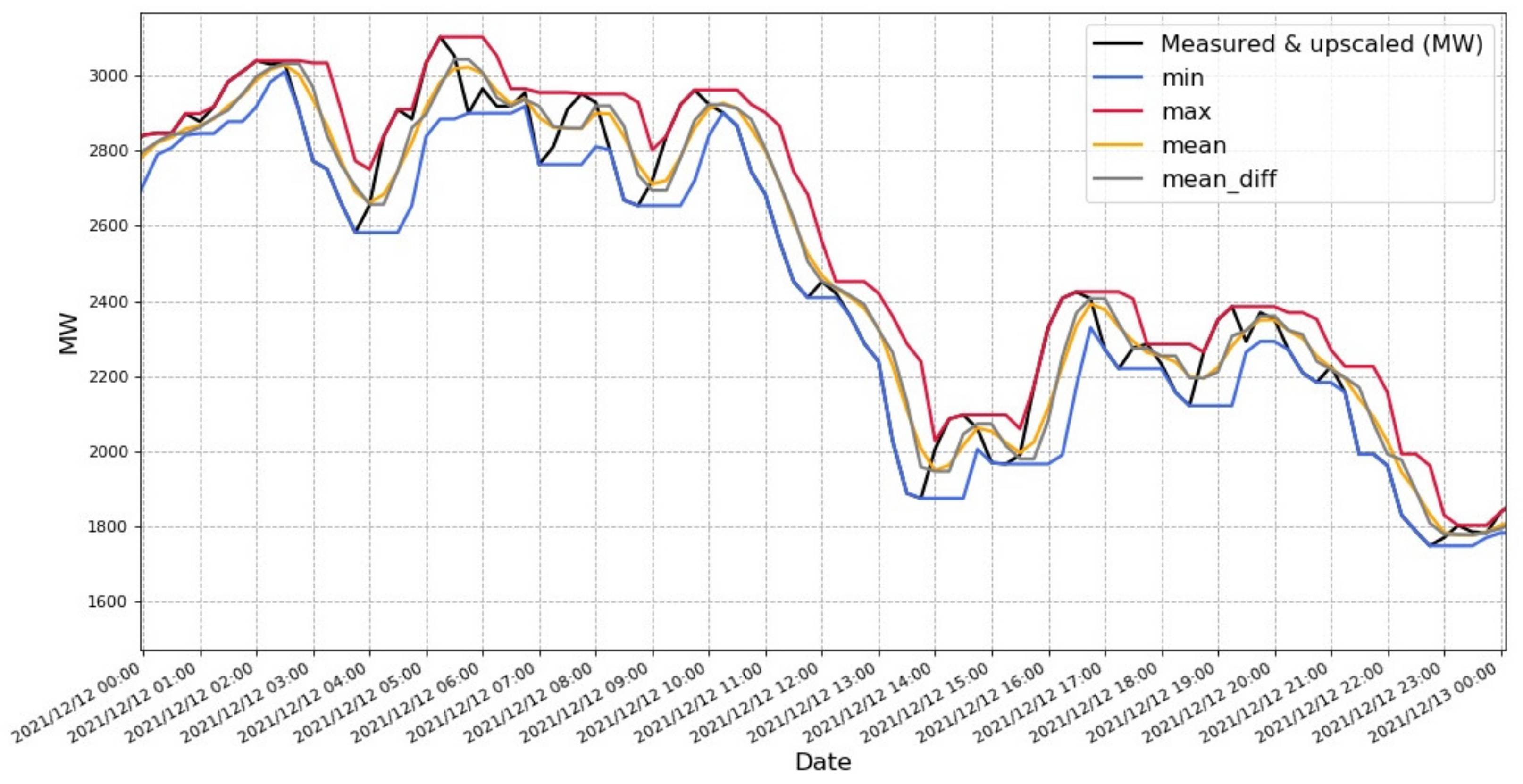
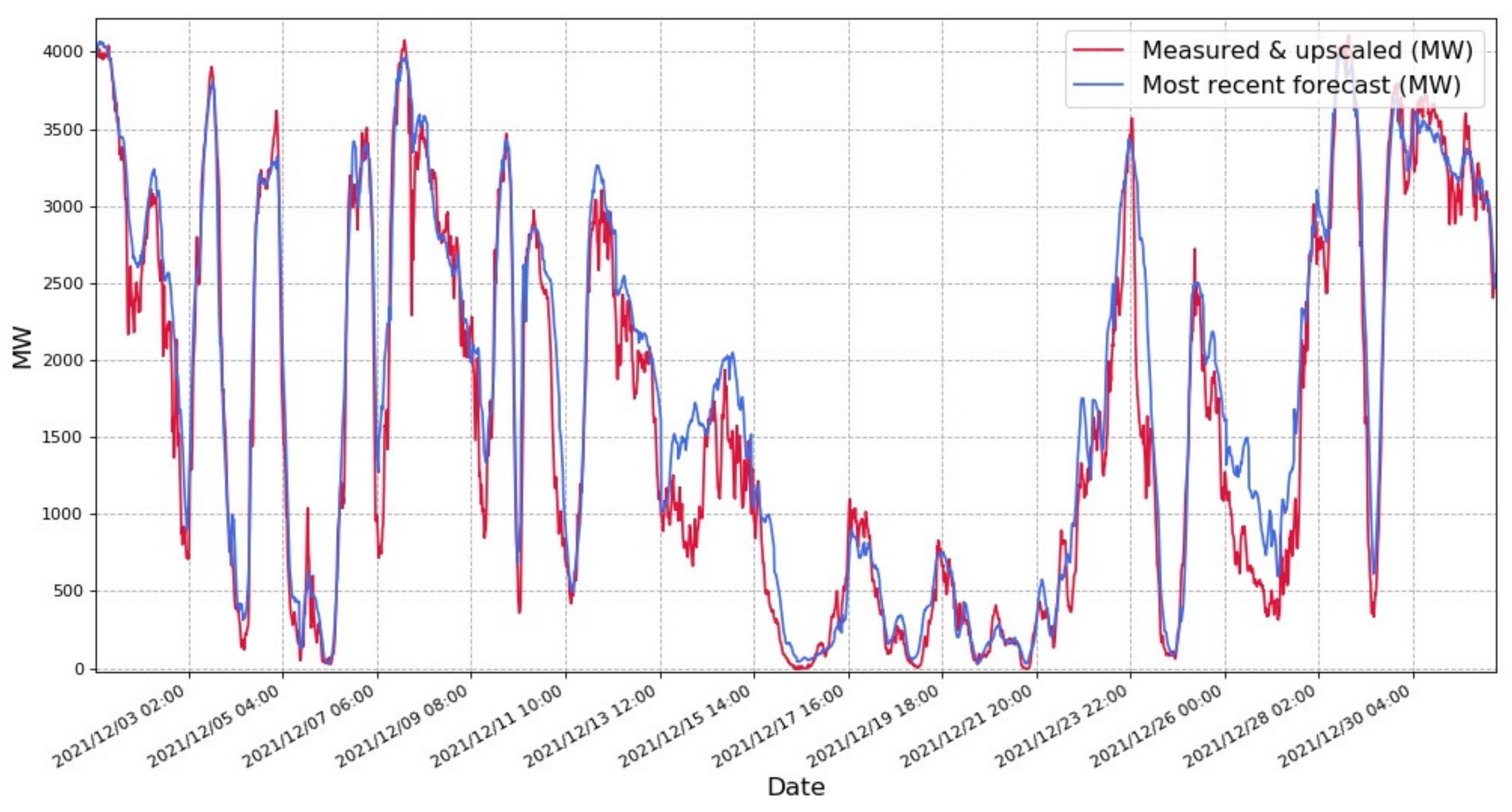
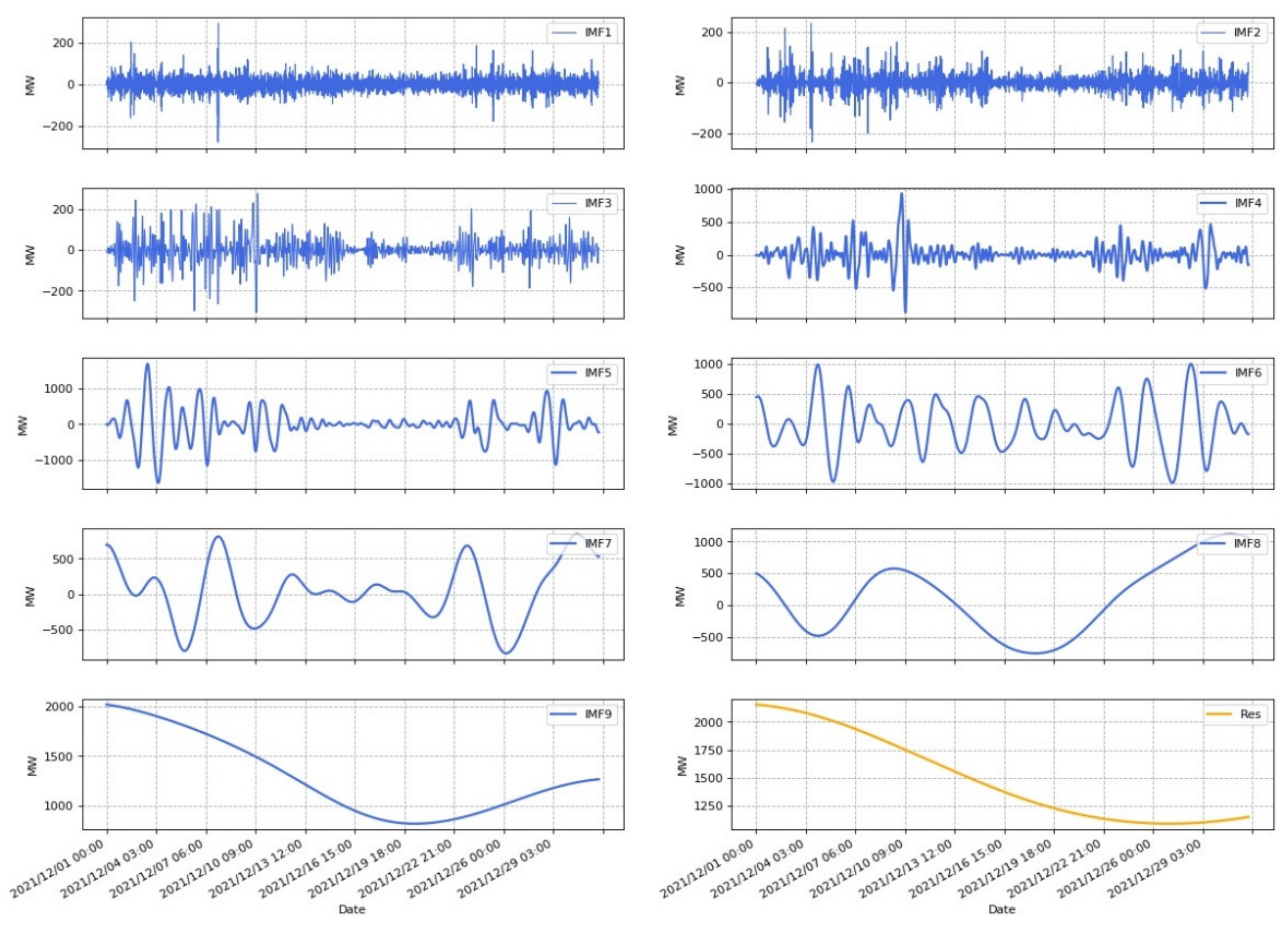
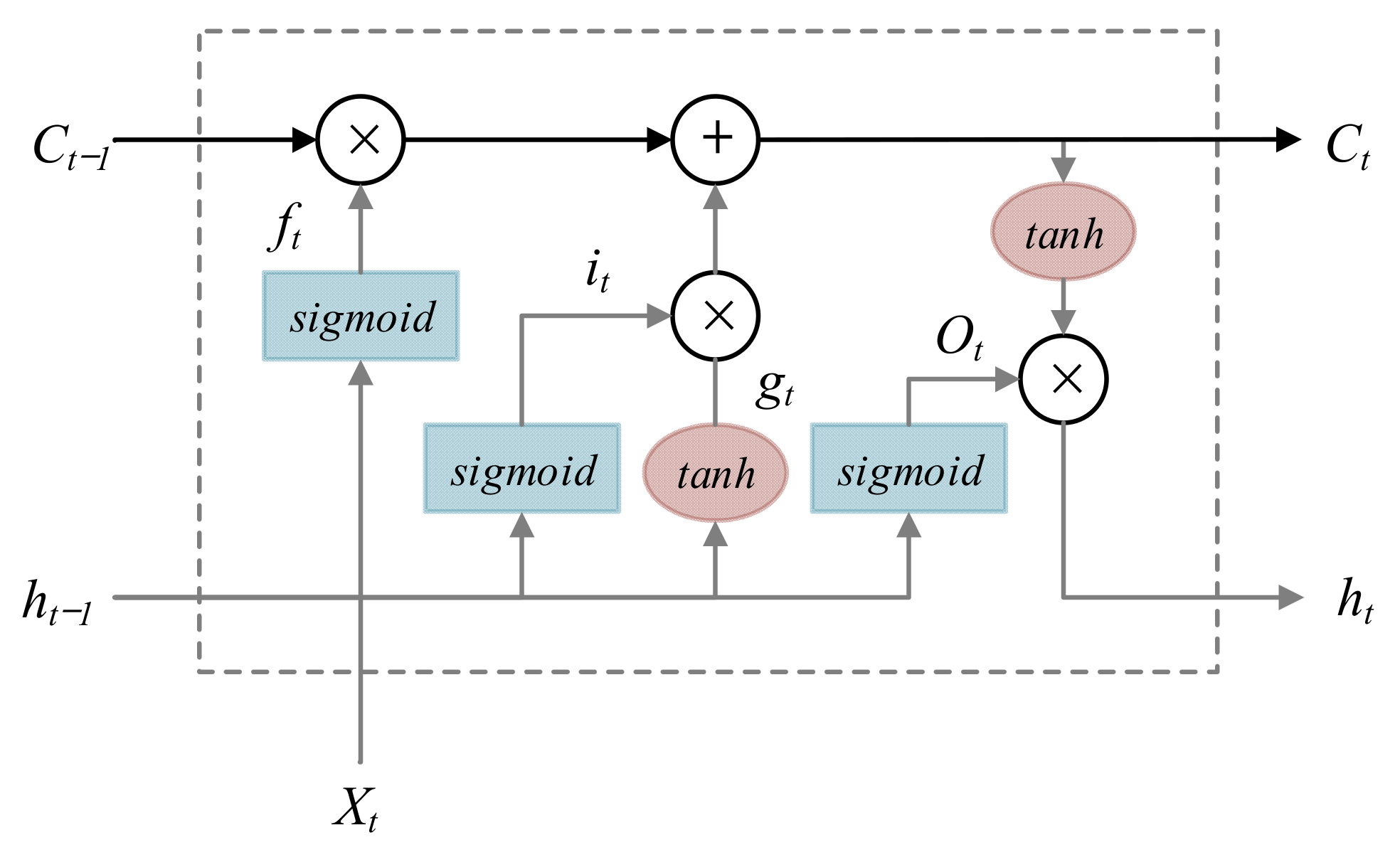



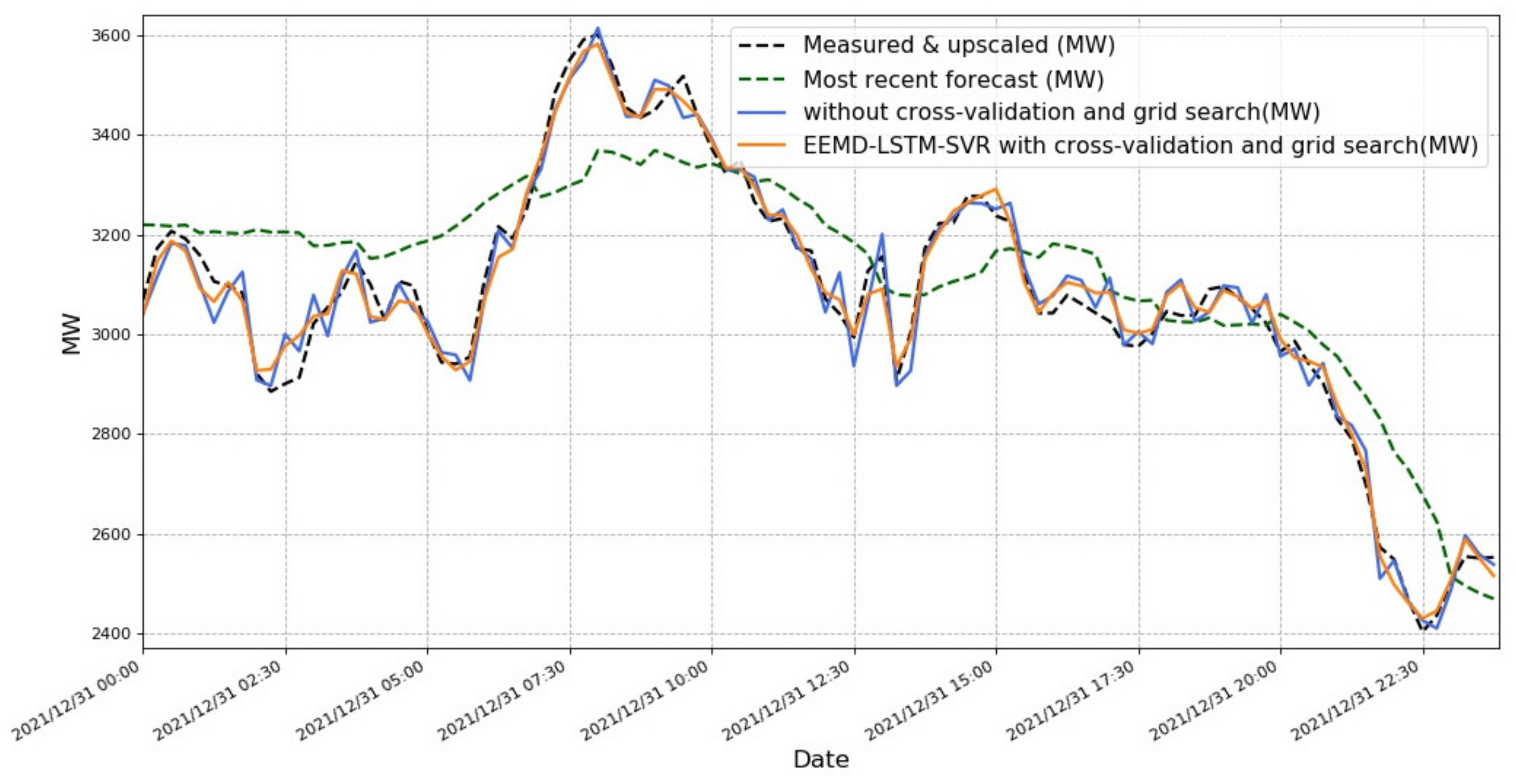
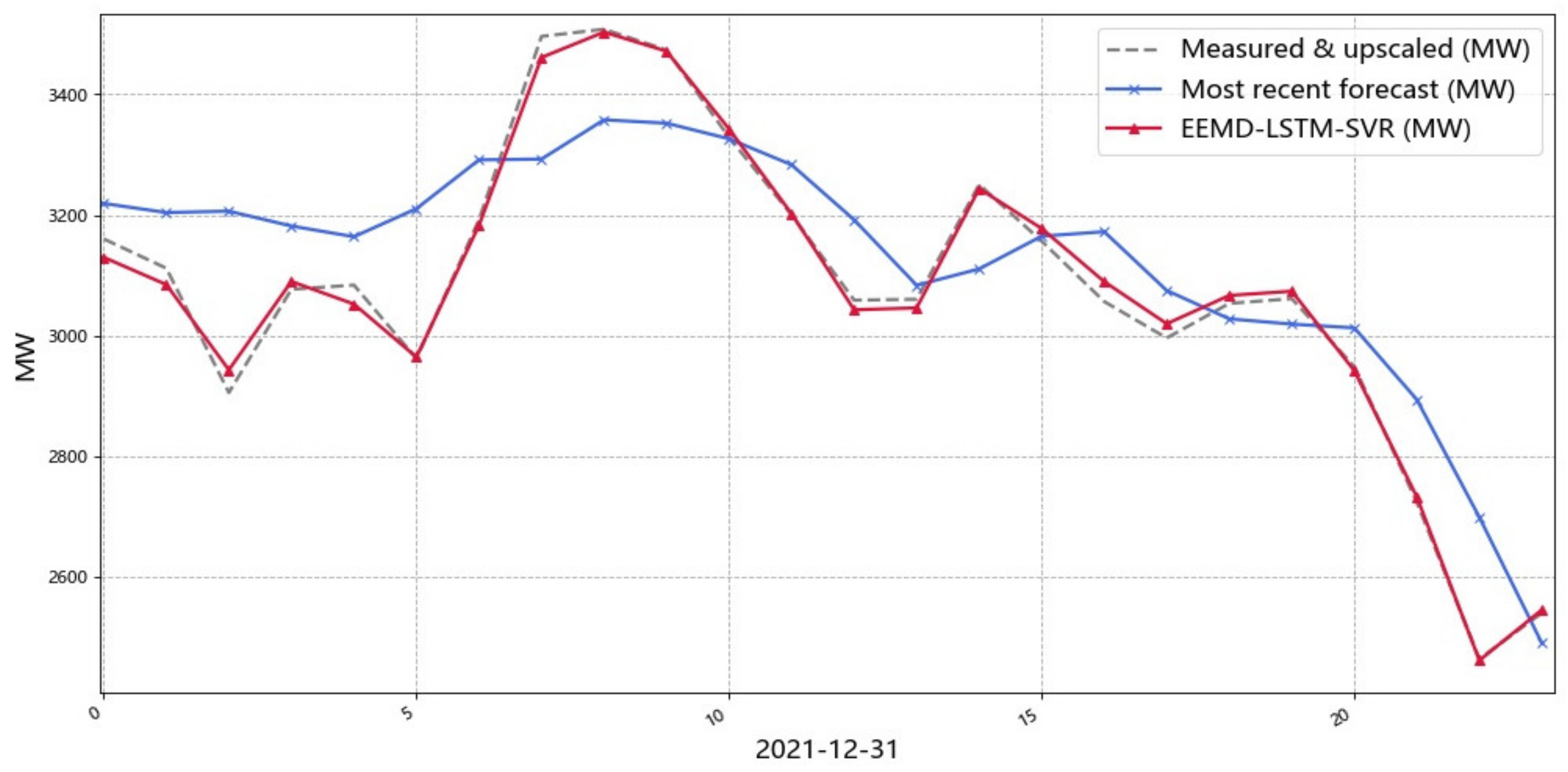
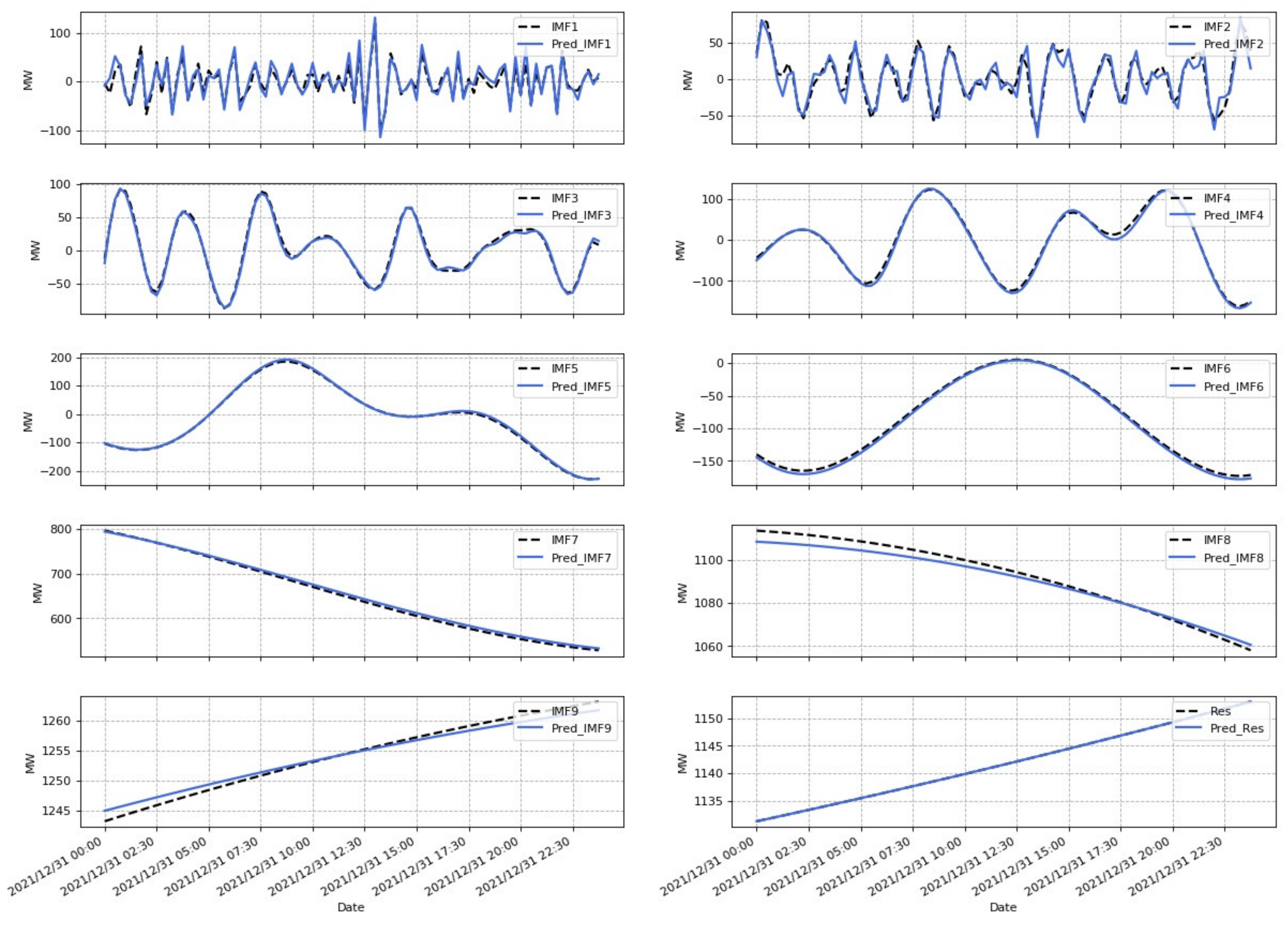


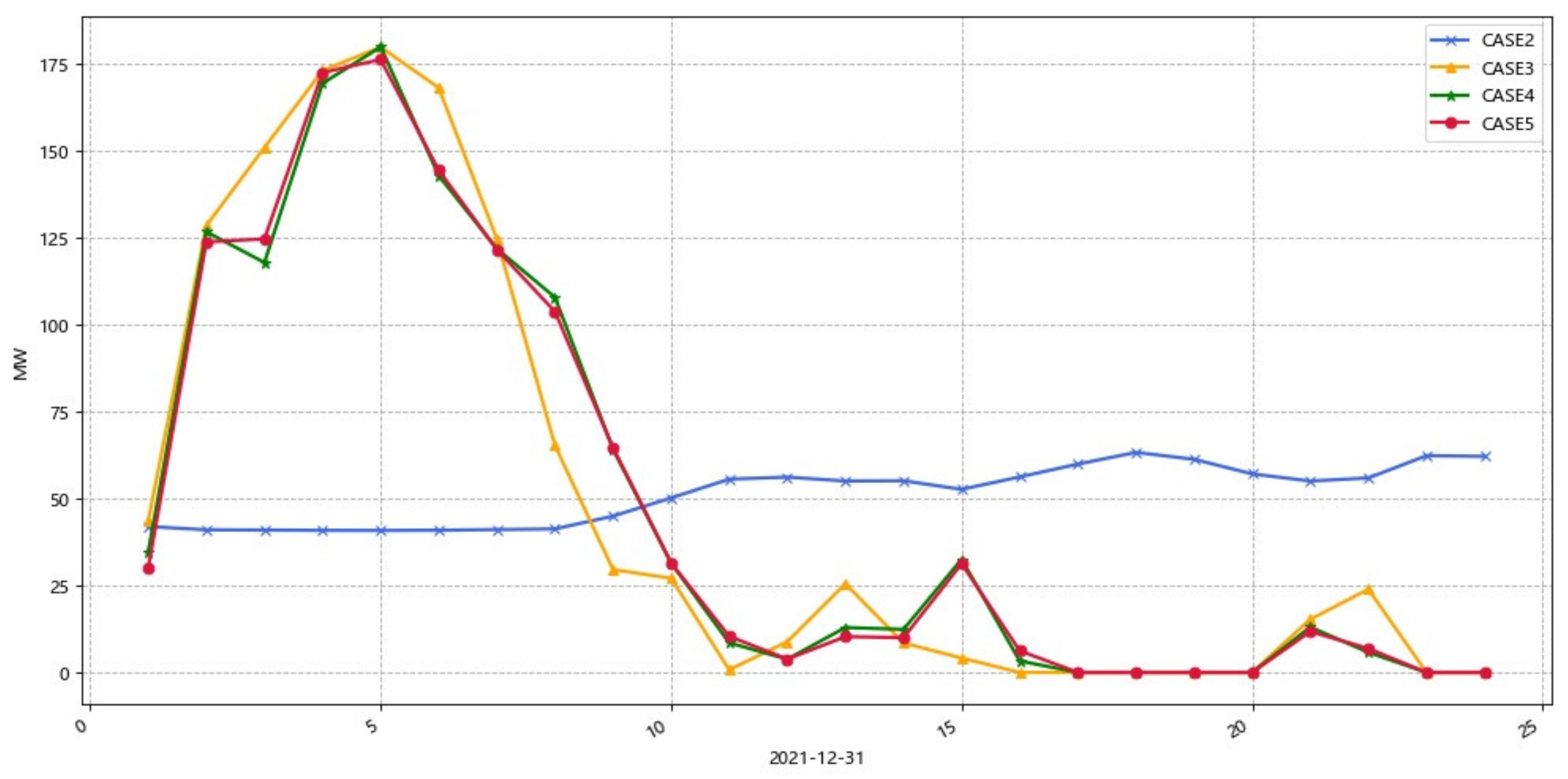

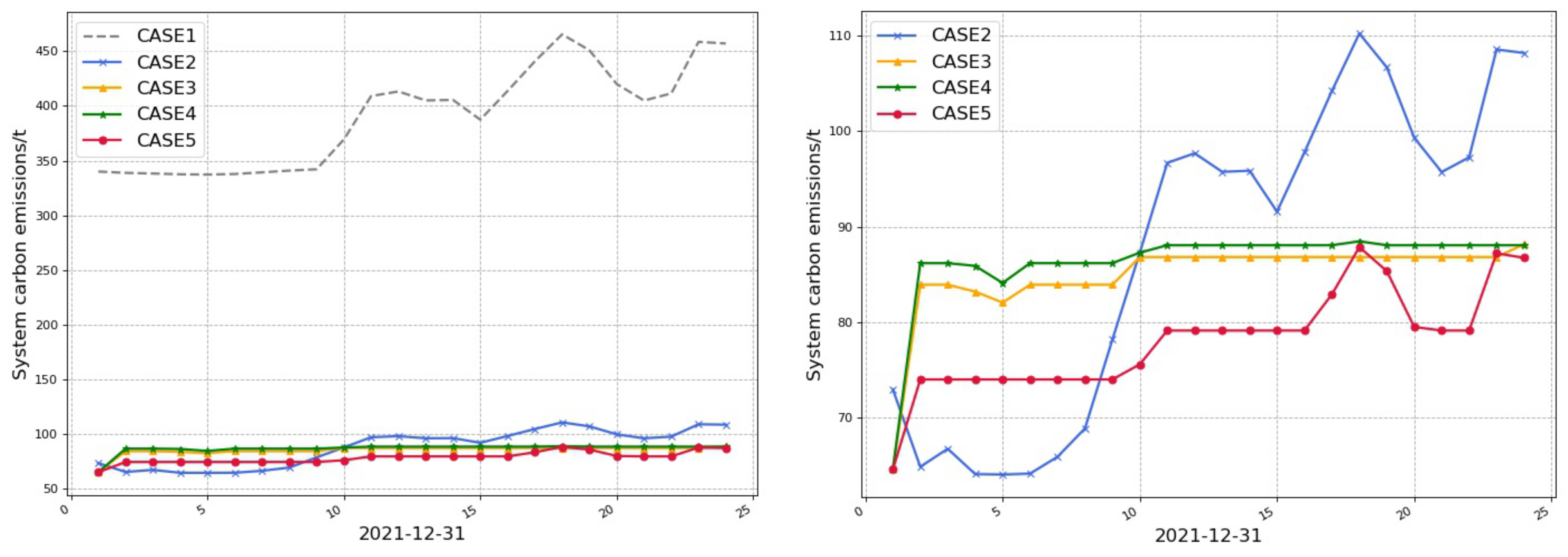
| MSE | RMSE | MAE | MAPE% | SMAPE% | R2 | |
|---|---|---|---|---|---|---|
| EEMD-LSTM-SVR | 0.001 | 0.031 | 0.025 | 6.185 | 6.924 | 0.985 |
| Without validation | 0.001 | 0.038 | 0.031 | 6.774 | 8.005 | 0.977 |
| Most recent forecast | 0.020 | 0.141 | 0.117 | 47.784 | 35.398 | 0.697 |
| LSTM | |
| hyperparameters | ranges |
| n_cell | [10,100] |
| n_batch | [10,100] |
| SVR | |
| hyperparameters | Ranges |
| Kernel functions | Linear, polynomial, RBF |
| Penalty factor C | [0.1,1] |
| Unit Number | Maximum Output | Minimum Output | Start-Stop Costs | Cost Parameter a | Cost Parameter b | Cost Parameter c | Minimum Start/Stop Time | Unit Climbing | Carbon Emission Intensity |
|---|---|---|---|---|---|---|---|---|---|
| 1 | 455 | 200 | 31,500 | 0.00336 | 113.33 | 7000 | 6 | 200 | 0.9 |
| 2 | 455 | 150 | 35,000 | 0.00217 | 120.82 | 6790 | 5 | 200 | 0.92 |
| 3 | 130 | 30 | 3850 | 0.014 | 116.2 | 4900 | 5 | 80 | 0.99 |
| 4 | 130 | 25 | 3920 | 0.01477 | 115.5 | 4760 | 5 | 80 | 0.98 |
| 5 | 162 | 45 | 6300 | 0.02786 | 137.9 | 2450 | 5 | 100 | 1.02 |
| 6 | 80 | 20 | 1190 | 0.04984 | 155.82 | 2590 | 3 | 72 | 1.05 |
| 7 | 85 | 25 | 1820 | 0.00553 | 194.18 | 3360 | 3 | 80 | 1.06 |
| 8 | 55 | 10 | 210 | 0.02891 | 181.44 | 4620 | 1 | 60 | 1.12 |
| 9 | 55 | 10 | 210 | 0.01554 | 190.89 | 4655 | 1 | 60 | 1.15 |
| 10 | 55 | 10 | 210 | 0.01211 | 194.53 | 4690 | 1 | 60 | 1.1 |
| Parameter Name | Value |
|---|---|
| (Energy consumption per unit of carbon capture)/((MW·h)/t) | 0.269 |
| (Carbon Capture Efficiency) | 0.9 |
| (Maximum operating condition)/% | 120 |
| MMEA (MEA Moore’s mass)/(g/mol) | 61.08 |
| MCO2 (CO2 molar mass)/(g/mol) | 44 |
| (The amount of regeneration tower can be resolved)/(molCO2/molMEA) | 0.24 |
| (Solution concentration)/% | 30 |
| (Solution density)/(t/m3) | 1.01 |
| (Carbon trading price)/($/t) | 120 |
| (Carbon emission allowance factor)/(t/(MW·h)) | 0.7 |
| (Day-ahead wind power reserve factor) | 0.2 |
| (Net Residual Value Rate)/% | 5 |
| NC (Depreciable life of liquid storage tank)/year | 5 |
| PCY (Liquid storage tank unit price)/($/m3) | 300 |
| VCY (Reservoir volume)/m3 | 60,000 × 4 |
| (Day-ahead load standby factor) | 0.05 |
| CZJ (Total price of carbon capture equipment)/US$ million | 165,159.4 |
| CGJ (Total cost of retrofit of regenerative tower compressor expansion to 120% capacity)/million $ | 14,264.3 |
| NT (Depreciable life of carbon capture equipment)/Year | 15 |
| (Cost of wind abandonment penalty)/($/(MW·h)) | 210 |
| Case 1 | Case 2 | Case 3 | Case 4 | Case 5 | |
|---|---|---|---|---|---|
| Operating Costs/$ | 307,159 | 504,703 | 495,644 | 500,406 | 500,274 |
| Cost of carbon emissions/$ | 51,289 | −154,728 | −149,898 | −152,511 | −152,438 |
| Wind Abandonment Costs/$ | 131,040 | 21,245 | 0 | 0 | 0 |
| Depreciation cost of storage fluid/$ | 0 | 0 | 47378 | 47,378 | 47,378 |
| Total Cost/$ | 489,489 | 371,221 | 393,125 | 395,274 | 395,214 |
| Carbon Emissions/t | 9364.786 | 2102.613 | 2037.048 | 2072.238 | 1874.986 |
| Abandoned wind/(MW⋅h) | 624.003 | 290.008 | 0 | 0 | 0 |
| Wind abandonment rate/% | 5.325% | 2.475% | 0 | 0 | 0 |
Publisher’s Note: MDPI stays neutral with regard to jurisdictional claims in published maps and institutional affiliations. |
© 2022 by the authors. Licensee MDPI, Basel, Switzerland. This article is an open access article distributed under the terms and conditions of the Creative Commons Attribution (CC BY) license (https://creativecommons.org/licenses/by/4.0/).
Share and Cite
Ding, C.; Zhou, Y.; Ding, Q.; Li, K. Integrated Carbon-Capture-Based Low-Carbon Economic Dispatch of Power Systems Based on EEMD-LSTM-SVR Wind Power Forecasting. Energies 2022, 15, 1613. https://doi.org/10.3390/en15051613
Ding C, Zhou Y, Ding Q, Li K. Integrated Carbon-Capture-Based Low-Carbon Economic Dispatch of Power Systems Based on EEMD-LSTM-SVR Wind Power Forecasting. Energies. 2022; 15(5):1613. https://doi.org/10.3390/en15051613
Chicago/Turabian StyleDing, Can, Yiyuan Zhou, Qingchang Ding, and Kaiming Li. 2022. "Integrated Carbon-Capture-Based Low-Carbon Economic Dispatch of Power Systems Based on EEMD-LSTM-SVR Wind Power Forecasting" Energies 15, no. 5: 1613. https://doi.org/10.3390/en15051613
APA StyleDing, C., Zhou, Y., Ding, Q., & Li, K. (2022). Integrated Carbon-Capture-Based Low-Carbon Economic Dispatch of Power Systems Based on EEMD-LSTM-SVR Wind Power Forecasting. Energies, 15(5), 1613. https://doi.org/10.3390/en15051613






